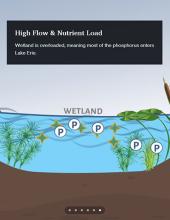
Wetlands are productive transition zones that connect land and water. They help filter pollutants from water, provide important habitats for a wide variety of plants and wildlife, and offer recreational opportunities for people. Since the mid 1800s, around 90% of Ohio's Lake Erie coastal wetlands have been lost due to farming, recreational activities, and urban development. Additional wetland restoration and enhancement along the coast and in the Lake Erie watershed have been identified as ways to help improve Lake Erie ’s water quality and reduce the occurrence of Harmful Algal Blooms.
About this resource
In collaboration with several regional partners, Old Woman Creek National Estuarine Research Reserve conducted a study aimed at understanding different wetlands' long-term capacity for removing nutrients. Together, they produced this story map that uses interactive maps, animations, and other graphics to illustrate the importance of wetland services, the different types of wetlands and management priorities, and how the team estimated long-term phosphorus retention capacities of a variety of wetland types based on samples collected from sites in Ohio, including the Lake Erie watershed.
Wetland managers can use the approach and monitoring protocol created by the project team to monitor water quality and estimate the long-term phosphorous retention capacity for wetlands that have a distinct inflow and outflow, where the rate of water flowing into the wetland can be measured. Results can help managers evaluate their wetland ’s long-term retention capacity with respect to average phosphorus loading to the wetland. Over time, managers can identify any changes in capacity as the wetlands age.
This promotional piece - Working Wetlands Rack Card - helps explain and promote the use of the story map.
Questions about the story map can be directed to:
Emily Kuzmick, Coastal Training Coordinator, Old Woman Creek NERR, [email protected]
Kristi Arend, Wetland Ecologist, [email protected]
Breann Hohman, Firelands Tributary Watershed Coordinator, Erie Soil and Water Conservation District, [email protected]